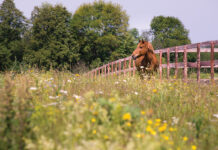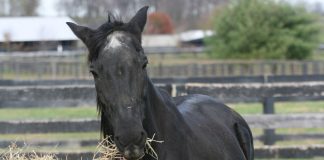 According to Kathryn Watts who heads up Rocky Mountain Research & Consulting Inc., there is no advantage to feeding “old” hay to horses that need lower nutritional requirements as a result of health conditions such as obesity or lamintis.
According to Kathryn Watts who heads up Rocky Mountain Research & Consulting Inc., there is no advantage to feeding “old” hay to horses that need lower nutritional requirements as a result of health conditions such as obesity or lamintis.
“As I travel around the world, learning and teaching people about feeding horses with laminitis, I keep hearing a recommendation that has never made sense,” Watts explains in her article. “People say that leaving hay in a shed for a year renders it ‘safe’ for horses with laminitis.”
Not so Watts concludes. But where did this idea of feeding old hay to laminitic or obese horses come from?
“While searching for the source of this myth, it was brought to my attention that in a 1966 edition of the Pony Club manual, a recommendation is given to feed ponies ‘old seed hay, preferably 12 to 18 months in the stack.’ Also: ‘Good old hay provides excellent keep for small stabled ponies,’” Watts explains. “While I value Pony Club advice for many things, it might be best to get advice for feeding laminitic ponies elsewhere. All this conflicting information needs to be put in the proper context of buying hay for horses that must have sugar and calories reduced.”
Watts has helped bring together research for horse owners on her website about the dangers of feeding grass with high sugar content. You can read her findings at www.safergrass.org; to read “Is Old Hay Better for Horses with Laminitis?” in its entirety, visit www.safergrass.org/articles/old_hay.htm.






Thanks for debunking myths!
Well, that makes sense but there is definitely lower quality hay with fewer nutrients.
interesting
So many discrepancies about laminitis…. Good ti have proper info!
3. Really a great piece of information.. But i am also sharing something new about horse health and this is an Android mobile application which highlights the diseases in horses.
For more information please
visit :www.horsesidevetguide.com
Great article. There’s a lot more to it when specializing a feed program for ponies, metabolic, IR, Cushings, founder and laminitis horses and breeds prone to sensitivities of too much sugar and starch.Educate yourself if you have a horse in one of those categories. Get your hay tested, soak it one hour in cold water if you do not have it tested yet to pull sugar out and drain properly. Timothy has been a great choice for my barn. Hay tests under the recommendation of stay u see 10% for NSC..nonstructural carbohydrates…if you do not understand ask your vet to look at hay analysis. Your horse or long eat what they are given by you..take the extra time to read and look into proper information..it will make the difference in the quality and quantity of years you have each other!